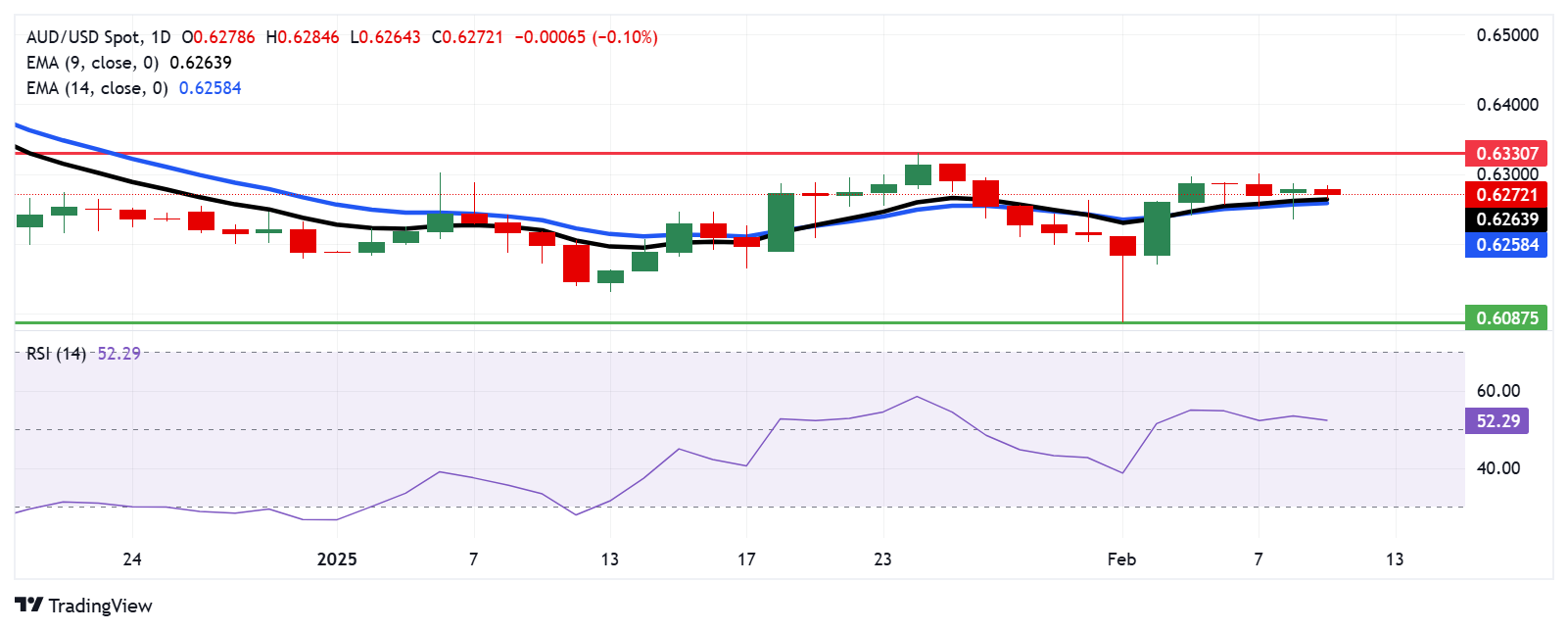- The Australian dollar depreciates while Trump imposes a 25% tariff on all imports of steel and aluminum.
- Westpac’s consumer confidence in Australia increased 0.1% in February, reaching 92.2 in January from 92.1 above.
- The US dollar can be seen in the midst of the growing cautious mood around the PCIUSE OF THE FED policy.
The Australian dollar (AUD) weakened against the US dollar (USD) on Tuesday as the downward pressure increased over the aud/usd torque. The fall followed the decision of the president of the United States, Donald Trump, to expand tariffs on steel and aluminum by 25% to include all imports, canceling trade agreements with key USed allies of the USA, including Australia. The White House confirmed that all import tax exclusions had been eliminated and indicated that additional action on microchips and vehicles in the coming weeks would be considered.
Westpac’s consumer confidence in Australia increased 0.1% in February, reaching 92.2 from 92.1 in January. Despite the slight increase, consumer confidence remained contained due to persistent concerns about household finances and increased cost of living.
The feeling of the market suggests growing expectations that the Australian Reserve Bank (RBA) will reduce its 4.35% cash at its next February meeting. Operators now see a 95% probability of a cut to 4.10%, since recent data indicate that underlying inflation has decreased faster than RBA anticipated. This has led several of the main Australian banks to change their prognosis for the first rate cut from May to February.
The Australian dollar falls in the midst of the growing cautious tone around the Fed policy prospects
- The US dollar index (DXY), which measures the value of the US dollar compared to six main currencies, rises above 108.00 at the time of writing. The dollar receives support since the Federal Reserve (FED) is expected to maintain stable interest rates this year, after the January employment report published on Friday, which indicated a slow labor growth but a lower unemployment rate.
- The US Non -Agricultural Payroll (NFP) increased by 143,000 in January, significantly below the December 307,000 figure and the market expectation of 170,000. However, the unemployment rate decreased slightly to 4% in January from 4.1% in December.
- The initial applications of unemployment subsidy in the US increased to 219K for the week that ended on January 31, according to the US Department of Labor (DOL) on Thursday. This figure exceeds the initial estimates of 213K and was higher than the total review of the previous week of 208k (of 207k).
- The president of the Bank of the Federal Reserve (FED) of Chicago, Austan Goolsbee, mentioned Friday that the inconsistent policy approaches of the US government cause a high level of economic uncertainty that makes it difficult to determine where it is directed The economy, and specifically, inflation.
- Meanwhile, the member of the Board of Governors of the FED, Adriana Kugler, said that economic growth and activity in the USA are still healthy in general, but observed that progress towards the inflation objectives of the Fed has been somewhat unequal, according to Reuters.
- In an interview with CNBC, the president of the FED of Minneapolis, Neel Kashkari, said he would support additional feature cuts if they see good inflation data and the labor market remains strong.
- China’s consumer pricing index (ICC) grew at an annual rate of 0.5% in January, compared to 0.1% in December and exceeding market forecast of 0.4%. In monthly terms, CPI inflation increased by 0.7%in January, compared to the flat reading of December of 0%, although it was below the expected increase of 0.8%.
Technical analysis: The Australian dollar proves the nine -day Ema, followed by 0.6250
The Aud/USD pair is around 0.6270 on Tuesday, testing the exponential mobile socks (EMA) of nine and 14 days in the daily chart. A rupture below these levels could weaken the impulse of the short -term price. The 14 -day relative force (RSI) index maintains its position above 50, suggesting that a bullish bias is active.
On the positive side, the Aud/USD torque could explore the region around the maximum of eight weeks of 0.6330, last reached on January 24.
The Aud/USD torque proves immediate support at the Nine Day EMA level of 0.6264, followed by the 14 days of 0.6258. A decisive breakdown below these levels could weaken the impulse of the short -term price, potentially pushing to 0.6087, the lowest level since April 2020, registered on February 3.
AUD/USD: Daily graphic
Australian dollar Price today
The lower table shows the percentage of change of the Australian dollar (AUD) compared to the main currencies today. Australian dollar was the weakest currency against the Swiss Franco.
| USD | EUR | GBP | JPY | CAD | Aud | NZD | CHF | |
|---|---|---|---|---|---|---|---|---|
| USD | 0.05% | 0.05% | 0.02% | 0.17% | 0.10% | 0.06% | -0.01% | |
| EUR | -0.05% | -0.02% | -0.06% | 0.13% | 0.05% | 0.03% | -0.06% | |
| GBP | -0.05% | 0.02% | -0.02% | 0.13% | 0.05% | 0.03% | -0.06% | |
| JPY | -0.02% | 0.06% | 0.02% | 0.16% | 0.08% | 0.06% | -0.02% | |
| CAD | -0.17% | -0.13% | -0.13% | -0.16% | -0.07% | -0.09% | -0.19% | |
| Aud | -0.10% | -0.05% | -0.05% | -0.08% | 0.07% | -0.02% | -0.12% | |
| NZD | -0.06% | -0.03% | -0.03% | -0.06% | 0.09% | 0.02% | -0.09% | |
| CHF | 0.01% | 0.06% | 0.06% | 0.02% | 0.19% | 0.12% | 0.09% |
The heat map shows the percentage changes of the main currencies. The base currency is selected from the left column, while the contribution currency is selected in the upper row. For example, if you choose the Australian dollar of the left column and move along the horizontal line to the US dollar, the percentage change shown in the box will represent the Aud (base)/USD (quotation).
Faqs Australian dollar
One of the most important factors for the Australian dollar (Aud) is the level of interest rates set by the Australian Reserve Bank (RBA). Since Australia is a country rich in resources, another key factor is the price of its greatest export, iron mineral. The health of the Chinese economy, its largest trading partner, is a factor, as well as inflation in Australia, its growth rate and commercial balance. The feeling of the market, that is, if investors are committed to more risky assets (Risk-on) or seek safe shelters (Risk-Off), it is also a factor, being the positive risk-on for the AUD.
The Australian Reserve Bank (RBA) influences the Australian dollar (AUD) by setting the level of interest rates that Australian banks can lend to each other. This influences the level of the interest rates of the economy as a whole. The main objective of the RBA is to maintain a stable inflation rate of 2% -3% by adjusting the interest rates or the low. Relatively high interest rates compared to other large central banks support the AU, and the opposite for the relatively low. The RBA can also use relaxation and quantitative hardening to influence credit conditions, being the first refusal for the AU and the second positive for the AUD.
China is Australia’s largest commercial partner, so the health of the Chinese economy greatly influences the value of the Australian dollar (Aud). When the Chinese economy goes well, it buys more raw materials, goods and services in Australia, which increases the demand of the AU and makes its value upload. The opposite occurs when the Chinese economy does not grow as fast as expected. Therefore, positive or negative surprises in Chinese growth data usually have a direct impact on the Australian dollar.
Iron mineral is the largest export in Australia, with 118,000 million dollars a year according to data from 2021, China being its main destination. The price of iron ore, therefore, can be a driver of the Australian dollar. Usually, if the price of iron ore rises, the Aud also does, since the aggregate demand of the currency increases. The opposite occurs when the price of low iron ore. The highest prices of the iron mineral also tend to lead to a greater probability of a positive commercial balance for Australia, which is also positive for the AUD.
The commercial balance, which is the difference between what a country earns with its exports and what it pays for its imports, is another factor that can influence the value of the Australian dollar. If Australia produces highly requested exports, its currency will gain value exclusively for the excess demand created by foreign buyers who wish to acquire their exports to what you spend on buying imports. Therefore, a positive net trade balance strengthens the AUD, with the opposite effect if the commercial balance is negative.
Source: Fx Street
I am Joshua Winder, a senior-level journalist and editor at World Stock Market. I specialize in covering news related to the stock market and economic trends. With more than 8 years of experience in this field, I have become an expert in financial reporting.








